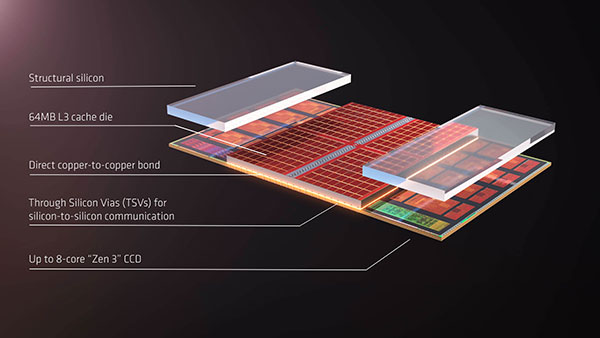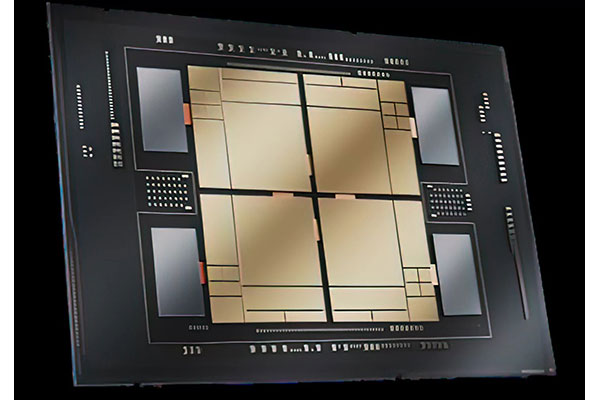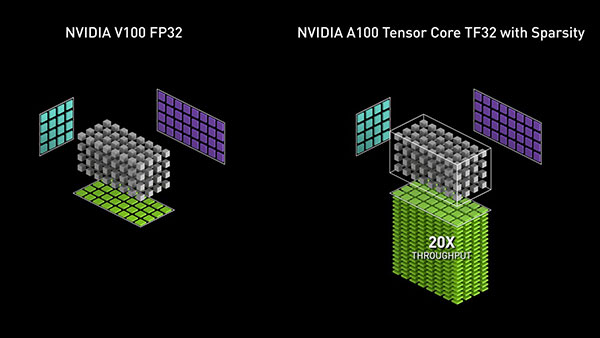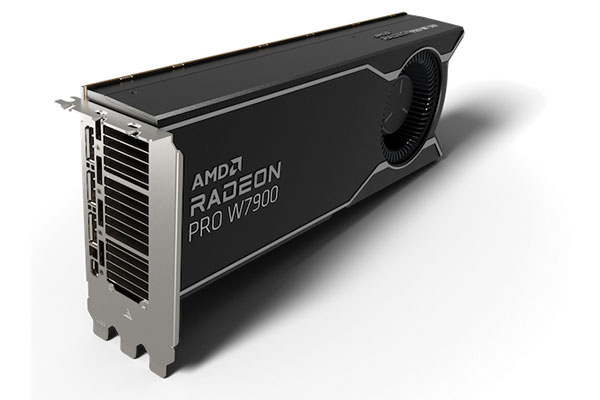Technology Reshapes Workstation Market
New processors are unlocking unprecedented levels of power for engineers.

AMD’s V-Cache is direct CPU memory. It sits above the existing L3 cache. Additional silicon is used to stiffen the die and convey heat to the heat spreader. Image courtesy of AMD.
Latest News
June 22, 2023
The year 2023 looks to be one of the most competitive in recent memory for the workstation graphics processing units (GPU) and CPU marketplace. On the CPU side, more workstation vendors are adopting AMD technology, providing new competition for Intel. In GPUs, the high-performance segment of the market still belongs to NVIDIA, but AMD GPUs are doing well for mainstream engineering and product development.
This is not a single battle over core counts and throughput. Suitability to purpose, energy efficiency and cost are all factors the buyer should consider. Just as there is no single right answer to the question “what workstation should we buy?,” there is no single right answer to which fundamental components are the best.
Sapphire Rapids vs. Zen 3
Intel recently introduced its Sapphire Rapids Xeon workstation processors, a new generation of CPU technology that the company claims can deliver a significant leap in performance. Research under the codename Sapphire Rapids started in 2015, and aimed for the day when design and manufacturability would align.
Sapphire Rapids CPUs feature a new compute architecture, faster cores and embedded multi-die interconnect bridge packaging. Bridging allows for easier scalability for the most demanding compute tasks. Intel claims the Sapphire Rapids flagship Xeon W9-3495X CPU offers performance improvements of up to 28% for single-thread processes and up to 120% for multithread processes compared to the previous generation. It can be ordered with up to 56 cores in a single socket. Contributing to this improvement is support for state-of-the-art components for memory (DDR5 registered dual-inline memory module or RDIMM) input/output (PCIe Gen 5.0) and connectivity (Wi-Fi 6E).
The newest Intel Sapphire Rapids Xeon chips also include up to 105MB of L3 cache for increased performance and data management, as well as eight channels of DDR5 RDIMM memory support, providing increased memory bandwidth for large data sets and memory-intensive workloads. The CPU can run at speeds up to 4.8 GHz.

Meanwhile, AMD has advanced its Ryzen Threadripper PRO processors, now in its second generation, and leveraged the Zen 3 microarchitecture. Threadripper PRO processors are currently reportedly the industry clock speed and core count champions. Many engineering tasks are still single-threaded processes; Threadripper PRO was designed with these tasks in mind.
AMD’s latest CPU performance iteration is 3D V-Cache, a technology that adds a small amount of high-bandwidth memory onto a processor chip. It is stacked in layers, thus the 3D in the name. A key driver for the technology is lowering latency. Frequently accessed data can be stored and retrieved quickly, without the need for accessing slower external memory sources. Faster access to data also provides increased energy efficiency.
The 3D V-Cache adds up to 64MB of extra cache to the processor, effectively doubling the cache from the previous generation. This technology is only being implemented on the Ryzen 5000 series.
More Tensors, Less Electricity
Tensor cores specialize in matrix math. They are used heavily for machine learning and related artificial intelligence tasks. They were first introduced by NVIDIA in 2017 with the release of the Volta generation of GPUs.

Tensor cores can perform matrix operations at a much faster rate than traditional general-purpose CPU or GPU cores. This makes them highly effective for tasks such as image and speech recognition, natural language processing, and other artificial intelligence applications. As with 3D Cache on a CPU, specialized cores in a GPU offer the double whammy of faster speed and more energy-efficient processing.
Tensor cores perform mixed-precision calculations faster than non-tensor core GPUs. To do this, they rely on 16-place “half” precision instead of 32-place “full” precision calculation. This reduces the number of arithmetic operations required, which has the byproduct of reducing energy consumption.
There are two more ways tensor cores save energy. Neural network models are “sparse”—they contain many “0” values. Tensor cores can take advantage of this sparsity by skipping computations for every “0” value encountered. By design, the tensor cores perform their math close to the PCIe interface, which minimizes data transfer between GPU and CPU memory. Less data movement—even in nanometers—means less energy consumed.
AMD does not offer tensor cores as a specialized component. Instead they have stream processors, which can perform matrix operations but are not specifically designed or optimized for deep learning. Stream processors work by breaking down computing tasks into small, discrete tasks that can be processed in parallel across multiple processors simultaneously. This allows for faster and more efficient processing, as well as greater flexibility in handling different types of workloads.
AMD stream processors work in conjunction with a GPU’s traditional graphics rendering capabilities to accelerate computing tasks that are not graphics oriented, providing speed improvements over traditional CPUs, according to AMD. AMD stream processors can be found in various Radeon graphics cards, such as the AMD Radeon VII. AMD says it excels in a variety of high-performance computing tasks, including scientific simulations, medical imaging and computer-aided design.
AMD also looks to its Infinity Fabric interconnect technology to offer a different approach to increased total efficiency. Infinity Fabric is a scalable fabric designed to connect to varying levels of components and modules to increase system throughput. It provides the ability to connect multiple chips or dies on a single package, allowing for better performance and increased energy efficiency. It supports error-correcting code (ECC) and direct memory access (DMA) technologies.
Smaller Is Better
NVIDIA has also made strides in its small form factor GPU offerings with the A6000 series, which offers advanced ray tracing and tensor core capabilities. These GPUs deliver substantial improvements in processing speed and energy efficiency, and are being sourced for many smaller deskside and mobile workstations.
All these new CPU and GPU technology updates will find their way into new models from all the leading workstation vendors in the next few months.
More AMD Coverage

More Intel Coverage
More NVIDIA Coverage
Subscribe to our FREE magazine, FREE email newsletters or both!
Latest News
About the Author
Randall S. Newton is principal analyst at Consilia Vektor, covering engineering technology. He has been part of the computer graphics industry in a variety of roles since 1985.
Follow DE







